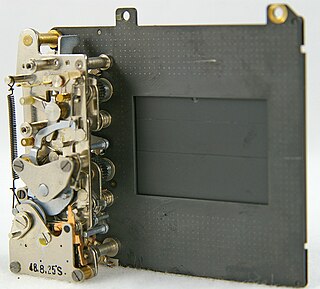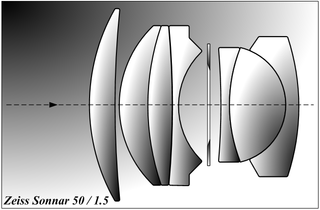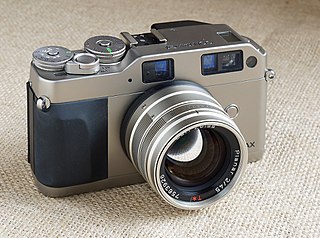
A single-lens reflex camera (SLR) is a camera that typically uses a mirror and prism system that permits the photographer to view through the lens and see exactly what will be captured. With twin lens reflex and rangefinder cameras, the viewed image could be significantly different from the final image. When the shutter button is pressed on most SLRs, the mirror flips out of the light path, allowing light to pass through to the light receptor and the image to be captured.

A rangefinder camera is a camera fitted with a rangefinder, typically a split-image rangefinder: a range-finding focusing mechanism allowing the photographer to measure the subject distance and take photographs that are in sharp focus. Most varieties of rangefinder show two images of the same subject, one of which moves when a calibrated wheel is turned; when the two images coincide and fuse into one, the distance can be read off the wheel. Older, non-coupled rangefinder cameras display the focusing distance and require the photographer to transfer the value to the lens focus ring; cameras without built-in rangefinders could have an external rangefinder fitted into the accessory shoe. Earlier cameras of this type had separate viewfinder and rangefinder windows; later the rangefinder was incorporated into the viewfinder. More modern designs have rangefinders coupled to the focusing mechanism so that the lens is focused correctly when the rangefinder images fuse; compare with the focusing screen in non-autofocus SLRs.

Carl Zeiss AG, branded as ZEISS, is a German manufacturer of optical systems and optoelectronics, founded in Jena, Germany in 1846 by optician Carl Zeiss. Together with Ernst Abbe and Otto Schott he laid the foundation for today's multi-national company. The current company emerged from a reunification of Carl Zeiss companies in East and West Germany with a consolidation phase in the 1990s. ZEISS is active in four business segments with approximately equal revenue in almost 50 countries, has 30 production sites and around 25 development sites worldwide.

In camera design, a focal-plane shutter (FPS) is a type of photographic shutter that is positioned immediately in front of the focal plane of the camera, that is, right in front of the photographic film or image sensor.

Zorki is the name of a series of 35mm rangefinder cameras manufactured in the Soviet Union between 1948 and 1978.
Kiev is a Soviet and Ukrainian brand of photographic equipment including cameras manufactured by the Arsenal Factory in Kyiv, Ukraine. The camera nameplates show the name "KIEV", with older cameras using "КИЕВ" or "КИЇВ" in Cyrillic.

Contax began as a German camera model in the Zeiss Ikon line in 1932, and later became a brand name. The early cameras were among the finest in the world, typically featuring high quality Zeiss interchangeable lenses. The final products under the Contax name were a line of 35 mm, medium format, and digital cameras engineered and manufactured by Japanese multinational Kyocera, and featuring modern Zeiss optics. In 2005, Kyocera announced that it would no longer produce Contax cameras. The rights to the brand are currently part of Carl Zeiss AG, but no Contax cameras are currently in production, and the brand is considered dormant.

The Zeiss Sonnar is a photographic lens originally designed by Dr. Ludwig Bertele in 1929 and patented by Zeiss Ikon. It was notable for its relatively light weight, simple design and fast aperture.

The Contax G camera line consists of two cameras, the G1 and G2, interchangeable-lens cameras sold by Kyocera under the Contax brand in competition with the Leica M7, Cosina Voigtländer Bessa-R, and Konica Hexar RF. The G1 was introduced in 1994 with the G2 joining it in 1996. In 2005, Kyocera retreated from the camera business and announced it would cease all activity related to the manufacture of Contax cameras at the end of the year, effectively spelling the end of the G system.

The Konica Hexar RF is a 35 mm rangefinder camera which was sold by Konica. It was introduced to the market on 13 October 1999. and subsequently discontinued some time before the end of 2003. The camera used the "Bayonet Konica KM-mount", a copy of the Leica M-mount, thus sharing interchangeable lenses with those designed for Leica cameras and others compatible with them. The Hexar RF has a combined rangefinder/viewfinder modeled on that of Leica cameras, a similar body shape and size - and so is similar to Leica M-mount cameras in many aspects of operation.

The Bessa family of cameras was manufactured in Japan by Cosina as a revival of the Voigtländer brand name between 1999 and 2015.

The Contaflex series is a family of 35mm Single-lens reflex cameras (SLR) equipped with a leaf shutter, produced by Zeiss Ikon in the 1950s and 1960s. The name was first used by Zeiss Ikon in 1935 for a 35mm Twin-lens reflex camera, the Contaflex TLR; for the earlier TLR, the -flex suffix referred to the integral reflex mirror for the viewfinder. The first SLR models, the Contaflex I and II have fixed lenses, while the later models have interchangeable lenses; eventually the Contaflexes became a camera system with a wide variety of accessories.

The Contax II is a 35 mm rangefinder camera. It was released in 1936 and was the successor of the original Contax later called the Contax I. It was the first camera with a rangefinder and viewfinder combined in a single window. Its chief designer was Hubert Nerwin. The Nettax was meant to be a cheaper alternative, it was a derivative of the Super Nettel with a rigid body and interchangeable lenses with a specific bayonet and a very limited range of lenses.
The design of photographic lenses for use in still or cine cameras is intended to produce a lens that yields the most acceptable rendition of the subject being photographed within a range of constraints that include cost, weight and materials. For many other optical devices such as telescopes, microscopes and theodolites where the visual image is observed but often not recorded the design can often be significantly simpler than is the case in a camera where every image is captured on film or image sensor and can be subject to detailed scrutiny at a later stage. Photographic lenses also include those used in enlargers and projectors.
The Jupiter series of lenses are Russian camera lenses made by various manufacturers in the former Soviet Union. They were made to fit many camera types of the time, from pre-WWII rangefinders to almost modern SLRs. They are copied from Zeiss pre-WWII designs with incremental improvements, such as coatings, introduced during production. The majority of them are based on Zeiss Sonnar optical scheme, but that's not a rule.

The "Sport" camera is the series production model of a prototype camera called Gelveta. The Gelveta was designed and built by A. O. Gelgar between 1934 and 1935. It is the earliest known production 35mm SLR camera ever to be built, but fewer than 320 examples were made. The actual launch date of the "Sport" is somewhat uncertain, however it was in series production by 1936 and must undoubtedly be one of the two earliest generally available SLR cameras using the 35mm film format, the other being the German Ihagee Kine Exakta, launched in 1936. It was manufactured by the Soviet camera factory Gosudarstvennyi Optiko-Mekhanicheskii Zavod, The State Optical-Mechanical Factory in Leningrad. GOMZ for short. The camera name is engraved in Cyrillic on the finder housing above the lens: „Спорm“. The manufacturer's prism logo in gold on black with the factory initials ГОМЗ (GOMZ) is shown behind a circular magnifying window on the top left camera front. An estimated number of 19,000 cameras were made before Leningrad was besieged in September 1941 and suffered heavy damage. The design concept was not continued later.

Contarex is a line of 35mm single lens reflex cameras (SLRs) made by Zeiss Ikon. It was first presented at Photokina in 1958 and initially scheduled for delivery in the spring of 1959, but it was not made generally available in the United States until March 1960. The first model is popularly known as the Contarex I, the Bullseye, or the Cyclops, after the prominent light meter window above the lens, in front of the pentaprism. The camera was aimed at the high-end and professional markets; in 1961, the retail price was $499.

The Leica copies originate from the Leica camera that was launched by Ernst Leitz, Wetzlar in 1925, using the Leica 39mm screw mount of 26 threads per inch, and the standard 35mm film. The design was carried out by Oskar Barnack, beginning in 1913 by building a camera for 24×36 mm negatives that by now is called the Ur-Leica, or Barnack Leica; but Ernst Leitz did not decide to manufacture it until 1924. Once started, the Leica production volume doubled each year; in 1929, some 16.000 cameras were produced. In 1930, an improved model with interchangeable lens was introduced, followed a year later by the fully developed Leica II with standardized film to lens flange distance, and in 1932 the basic Leica Standard; the Leica concept was established. This camera's features are the basis for defining a Leica copy.

The Zeiss Hologon is an ultra wide-angle f=15mm f/8 triplet lens, providing a 110° angle of view for 35mm format cameras. The Hologon was originally fitted to a dedicated camera, the Zeiss Ikon Contarex Hologon in the late 1960s; as sales of that camera were poor and the Zeiss Ikon company itself was going bankrupt, an additional 225 lenses were made in Leica M mount and released for sale in 1972 as the only Zeiss-branded lenses for Leica rangefinders until the ZM line was released in 2005. The Hologon name was revived in 1994 for a recomputed f=16mm f/8 lens fitted to the Contax G series of rangefinder cameras.

Prominent refers to two distinct lines of rangefinder cameras made by Voigtländer.


















